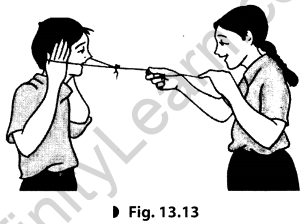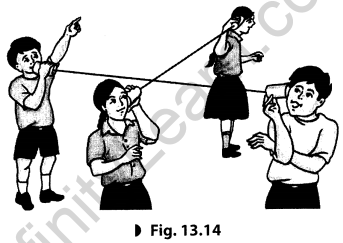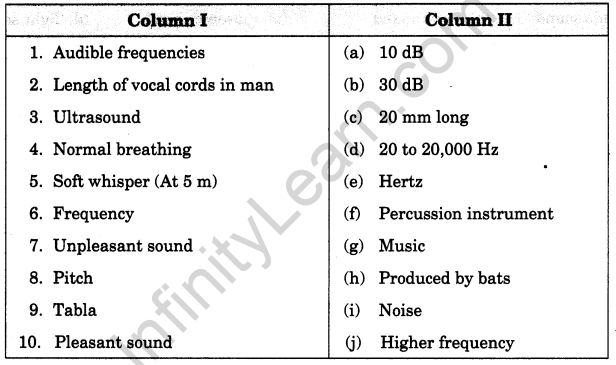Table of Contents
Sound Class 8 Extra Questions Science Chapter 13
Sound Class 8 Extra Questions Very Short Answer Questions
Question 1.
What does voice box or larynx of human produces?
Answer:
Sound
Question 2.
In which medium sound propagates the maximum?
Answer:
Solid
Question 3.
Name the sound producing organ in human.
Answer:
Larynx
Question 4.
What is vibration?
Answer:
Back and forth motion of an object.
Question 5.
Do all bodies produce sound?
Answer:
No
Question 6.
How is sound produced?
Answer:
By vibrating bodies.
Question 7.
Name a musical instrument which produces sound by blowing air into it.
Answer:
Flute
Question 8.
What is the unit of frequency?
Answer:
Hertz
Question 9.
What do you mean amplitude?
Answer:
Vibrations produced by vibrating body in one second is known as amplitude.
Question 10.
What is the maximum displacement of an oscillating object is called?
Answer:
Amplitude
Question 11.
How does sound help us?
Answer:
Sound help us to communicate.
Question 12.
What is the unit of loudness?
Answer:
Decibel (dB)
Question 13.
What is audible sound?
Answer:
Frequency between 20 Hz to 20,000 Hz is audible sound.
Question 14.
In which medium sound travels faster?
Answer:
Solid
Sound Class 8 Extra Questions Short Answer Questions
Question 1.
A simple pendulum makes 20 oscillations in 40 seconds. What is the time period and frequency of its oscillation?
Answer:
Time period = \(\frac{\text { Time }}{\text { No. of oscillation }}=\frac{40}{20}\) = 2 sec.
Frequency = \(\frac{\text { No. of oscillation }}{\text { Time }}=\frac{20}{40}\) = 0.5 Hz
Question 2.
Sonali heard sound of thunderbolt 5 second after she saw flash of lightning. How far is she from the place where lightning occurs? (speed of sound = 330 m/s)
Answer:
Distance of Sonali from the place of lightning = 330 × 5 = 1650 m
Question 3.
What is frequency?
Answer:
The number of oscillations per second is called frequency. Its unit is hertz.
Question 4.
What do you mean by oscillatory motion?
Answer:
The to and fro motion of an object is called vibration. This motion in both the direction from its mean position is called oscillatory motion.
Question 5.
Two astronauts are floating close to each other in space. Can they talk to each other without using any special device? Give reasons.
Answer:
No, because in space there is no atmosphere and sound needs medium to travel.
Question 6.
What do you mean by time period?
Answer:
The time taken by a vibrating body to complete one oscillation is called the time period.
Question 7.
What are the harms of noise pollution?
Answer:
Lack of sleep, hypertension, anxiety and temporary or even permanent impairment of hearing.
Question 8.
What do you mean by audible sound?
Answer:
The sound which we can hear clearly is known as audible sound. It has a range of frequencies from 20 Hz to 20,000 Hz.
Question 9.
What are infrasonic sounds?
Answer:
Sounds which have frequency lower than 20 Hz are called infrasonic sounds.
Question 10.
What is noise pollution?
Answer:
The presence of unwanted and excessive sound in the environment is called noise pollution.
Sound Class 8 Extra Questions Long Answer Questions
Question 1.
State the differences between ultrasonic sound and infrasonic sound?
Answer:
| Ultrasonic sound | Infrasonic sound |
| (i) Sound of frequency higher than 20,000 Hz is called ultrasonic sound. | (i) Sound of frequency lower than 20 Hz is called the infrasonic sound. |
| (ii) Animals like dog, bat, monkey, deer, etc., can hear ultrasonic sound. | (ii) Animals like whale, elephant, hippopotamus, giraffe, etc., can hear infrasonic sound. |
Question 2.
What are the methods to control noise pollution?
Answer:
Following are the methods to control noise pollution:
- The noise pollution can be controlled by reducing the respective sources of noise pollution.
- The blowing of horns and speaker should be strictly avoided near schools and hospitals.
- More and more trees should be planted on roadside because trees absorb sound.
Question 3.
What is the property of vibration which determines the pitch of the sound?
Answer:
The frequency is the property which determines the shrillness or pitch of a sound. If the frequency of a sound is higher then we say that the sound has lower pitch.
Question 4.
Define frequency.
Answer:
The number of oscillations completed by a vibrating body in one second is called frequency. The unit of frequency is hertz. It is denoted by Hz. If a vibrating body makes 20 oscillations in a second we say that its frequency is 20 Hz. The human voice can produce frequency between 60 Hz and 13,000 Hz. It is interesting that a human ear can hear sound of frequency between 20 Hz to 20,000 Hz.
Question 5.
A string musical instrument was first plucked with a force of smaller magnitude and then with a force of greater magnitude. In which case would the instrument produce a louder sound?
Answer:
The loudness of sound depends upon the amplitude of vibration. The amplitude of string is larger when it is plucked with greater force and hence the sound will be louder in that case.
Question 6.
Differentiate between musical sound and noise.
Answer:
| Musical sound | Noise |
| (i) Musical sound is pleasant, smooth and agreeable to the ear. | (i) Noise is unpleasant, jarring and disagreeable to the ear. |
| (ii) It is produced by periodic vibrations which are regular and continuous. | (ii) It is produced by irregular vibrations which are discontinuous. |
| (iii) There are no sudden changes in loudness and pitch of musical sound. | (iii) There are sudden changes in loudness and pitch of noise. |
Sound Class 8 Extra Questions Higher Order Thinking Skills
Question 1.
How is sound produced and how is it transmitted and heard by us?
Answer:
Sound is a form of energy produced and transmitted by a vibrating matter. It travels in form of waves through matter and moves in to and fro direction. When this wave reach eardrum it makes the eardrum to vibrate. The eardrum sends vibrations to the inner ear. From there, the signal goes to the brain and we are able to hear the sound.
Question 2.
Suppose a bell is ringing in a vacuum. Will you able to hear the sound?
Answer:
We will not be able to hear the sound of vibration because sound cannot travel in vacuum.
Question 3.
What is the function of hair and wax in ear canal?
Answer:
The hair and wax in the ear canal help to keep out foreign debris such as dirt and bugs.
Question 4.
When we speak and hear, does any part of our body vibrate? Name them.
Answer:
Yes. When we speak, vocal cords vibrate to produce sound and when we hear, eardrum vibrate to receive the sound wave.
Question 5.
We have learnt that vibration is necessary for producing sound. Explain why the sound produced by every vibrating body cannot be heard by us.
Answer:
If the sound of vibrating body is audible then only we will be able to heard it otherwise we will not be able to hear it.
Question 6.
Why we are able to hear sound of a clock clearer at night than in day?
Answer:
The noise level is quite low at night. Therefore the sound of the clock appears much clearer at night than in the day.
Sound Class 8 Extra Questions Value-Based Questions
Question 1.
On Ramesh’s 13th birthday, his father invited all his friends and their relatives. It was a big party with lots of food and DJs. Ramesh didn’t like the loud sound of DJs and asked his father to play it in a low volume so that their neighbours do not get much disturbed and people in the party can also enjoy the music. Ramesh’s father felt good for his wisdom and did as he said.
- Do you enjoy loud sound DJs in parties?
- Do you think when loud music is played in a party is acceptable to all the people living in , neighbourhood?
- How can you control noise pollution at your end?
- What value of Ramesh is shown here?
Answer:
- Yes/No (according to your choice)
- No, it may be not acceptable to all the people living in neighbourhood.
- We can control noise pollution at our end by:
- not playing music loudly.
- planting trees around house.
- cushioning gaps in windows and doors.
- using ear plugs at noisy places.
- doing meditation.
- Ramesh is wise, mature, knows hazards of noise pollution, concern about others and good-hearted.
Activities and Projects
Question 1.
Visit the music room of your school. You may also visit musicians in your locality. Make a visit of musical instruments. Note down the parts of these instruments that vibrate to produce sound.
Answer:
Do it yourself.
Question 2.
If you play a musical instrument, bring it to the class and demonstrate how you play it.
Answer:
Do it yourself.
Question 3.
Prepare a list of famous Indian musicians and the instruments they play.
Answer:
(a) Ustad Amjad Ali Khan – Sarod
(b) Bismillah Khan – Sehnai
(c) Hariprasad Chaurasia – Flute
(d) Zakir Hussain – Tabla
(e) Ravi Shankar – Sitar
Question 4.
Take a long thread. Place your hands over your ears and get some one to place this thread round your head and hands. Ask her to make the thread taut and hold its ends in one hand. Now ask her to draw her finger and thumb tightly along the thread (Fig. 13.13). Can you hear a rolling sound like that of a thunder? Now repeat the activity while another Mend stands near both of you. Can he hear any sound?

Answer:
Yes.
Question 5.
Make two toy telephones. Use them as shown in Fig. 13.14. Make sure that the two strings are taut and touch each other. Let one of you speak. Can the remaining three persons hear? See how many more friends you can engage in this way. Explain your observations.

Answer:
Yes, remaining three persons can hear because sound can travel through string.
Question 6.
Identify the sources of noise pollution in your locality. Discuss with your parents, friends and neighbours. Suggest how to control noise ) Fig. 13.14
pollution. Prepare a brief note and present it in the class.
You can read more on the related topics on the following websites:
- www.physicsclassroom.com/Class/sound/soundtoc.html
- health.howstuffworks.com/hearing.htm
Answer:
Sources of noise pollution are as follows:
- Sound from factories
- Sound from crackers
- Vehicles on road
- Sound from construction sites
- Sound from loudspeakers
Noise pollution can be effectively controlled by taking the following measures:
- For people working in noisy installations can use ear-protection aids like ear-plugs, ear-muffs, noise 5 helmets, headphones, etc.
- Designing, fabricating and using quieter machines to replace the noisy ones.
- Proper lubrication and better maintenance of machines.
- Using silencers to control noise from automobiles, ducts, exhausts, etc.
- Increasing distance between source and receiver by zoning of noisy industrial areas, bus terminals and railway stations, aerodromes, etc., away from the residential area.
- Sound travels through the cracks so filling the gaps of doors and windows with sound absorbing materials.
- Insulation of sound by constructing windows with double or triple panes of glass.
- Planting green trees and shrubs along roads, hospitals, educational institutions, etc., help in noise reduction to a considerable extent.
- Strict legislative measures need to be enforced to curb the menace of noise pollution like no use of loudspeakers and amplifiers especially near school and hospitals,.banning unnecessary horns by automobiles, etc.
I. Multiple Choice Questions (MCQs)
Choose the correct option.
Question 1.
The voice box is also called as
(a) stomach
(b) heart
(c) larynx
(d) mouth
Question 2.
Sound is a kind of
(a) work
(b) energy
(c) force
(d) pressure
Question 3.
The hearing range of human ear is
(a) 20 Hz to 20,000 Hz
(b) less than 20 Hz
(c) more than 20,000 Hz
(d) 20 Hz to 25,000 Hz
Question 4.
Pitch of sound is determined by its
(a) frequency
(b) speed
(c) amplitude
(d) loudness
Question 5.
The frequency of subsonic sound is
(a) more than 20 Hz
(b) 100 Hz
(c) less than 20 Hz
(d) more than 20,000 Hz
Question 6.
Cochlea is a part of
(a) hearing organ
(b) sound producing organ
(c) muscular organ
(d) air pollution
Question 7.
1 hertz is equal to
(a) 1 vibration per minute
(b) 10 vibrations per minute
(c) 60 vibrations per minute
(d) 600 vibrations per minute
Question 8.
Sound cannot travel through
(a) air
(b) water
(c) air
(d) vacuum
Question 9.
The sound in the audible range is called
(a) ultrasonic sound
(b) sonic sound
(c) subonic sound
(d) light sound
Question 10.
Speed is
(a) \(\frac{\text { Distance travelled }}{\text { Time }}\)
(b) \(\frac{\text { Time }}{\text { Distance travelled }}\)
(c) Distance travelled × Time
(d) Time + Distance travelled
Question 11.
A pendulum oscillates 20 times in 4 seconds. Find its time period.
(a) 0.05 sec.
(b) 0.001 sec.
(c) 0.2 sec.
(d) 0.1 sec
Question 12.
Loudness of sound is determined by
(a) pitch
(b) frequency
(c) amplitude
(d) time period
Question 13.
The number of vibrations made by a vibrating body in one second is
(a) frequency
(b) noise
(c) loudness
(d) pitch
Question 14.
The maximum displacement of a body from its mean position is called
(a) amplitude
(b) oscillation
(c) periodic motion
(d) frequency
Question 15.
The velocity of sound at 20°C is approximately
(a) 3400 m/sec.
(b) 340 m/sec.
(c) 430 m/sec
(d) 304 m/sec.
Answer:
1. (c)
2. (b)
3. (a)
4. (a)
5. (c)
6. (a)
7. (c)
8. (d)
9. (b)
10. (a)
11. (c)
12. (c)
13. (a)
14. (a)
15. (b)
II. Fill in the Blanks
Fill in the blanks with suitable word/s.
1. human beings sound is produced by __________.
2. Sound of frequency lower than 20 Hz is called the __________.
3. The __________ nerve is also present in the inner ear.
4. Sounds which are unpleasant to the ear is called __________.
5. Too much noise in our surroundings that causes discomfort is called __________.
6. The speed of sound is maximum in __________.
7. Sounds of frequencies higher than 20,000 Hz are called the __________ sound.
8. __________ is the time taken by a vibrating body for one complete vibration.
9. Above __________ the noise becomes physically painful.
10. Plantation on the roadside can reduce __________.
11. The hearing range of human ears is __________.
12. The loudness of normal breathing of human is __________.
13. Vibration is a repeated __________ and __________ motion.
14. The loudness of sound is determined by the __________ of vibration.
15. The human voice box is called __________.
Answer:
1. larynx
2. infrasonic
3. auditory
4. noise
5. noise pollution
6. solids
7. ultrasonic
8. Time period
9. 80 dB
10. noise pollution
11. 20 Hz to 20,000 Hz
12. 10 dB
13. to, fro
14. amplitude
15. larynx
III. Match the following
Match the items given in column I suitably with those given in column II.

Answer:
1. (d)
2. (c)
3. (h)
4. (a)
5. (b)
6. (e)
7. (i)
8. (j)
9. (f)
10. (g)
IV. True or False
State whether the given statements are true or false.
1. All human beings can hear sounds of frequencies upto 60,000 Hz.
2. The sound in a sitar is produced by plucking its strings.
3. Sound cannot travel through vacuum.
4. Sound does not need a medium for its propagation.
5. The loudness is expressed in a unit called decibel.
6. Loud sounds have high frequencies.
7. Sound travel faster in air, slower in iron.
8. Light travels much faster than sound.
9. Man cannot hear sound of bats.
10. The time taken to complete one oscillation is called frequency.
11. Shriller sound has more frequency.
12. Tabla is a musical instrument.
13. The sound could not travel in solid.
14. The pitch of a sound depends in the frequency of the waves.
Answer:
1. False
2. True
3. True
4. False
5. True
6. False
7. False
8. True
9. True
10. False
11. True
12. True
13. False
14. True








